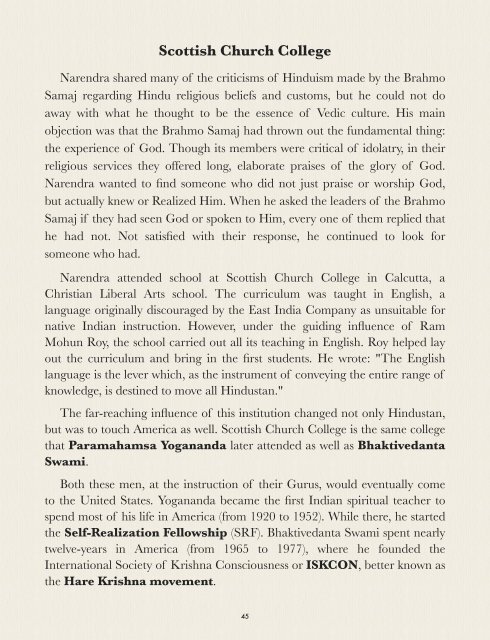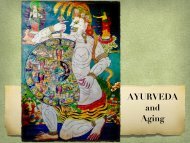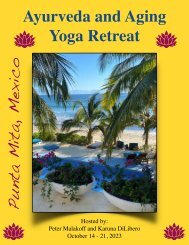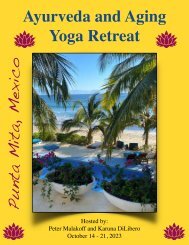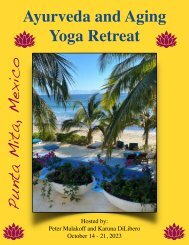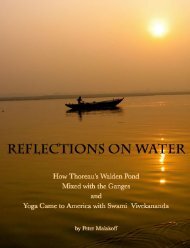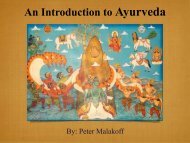How Thoreau's Walden Pond Mixed with the Ganges and Yoga Came to America with Swami Vivekananda
One early morning in 1846, during the coldest days of a New England winter, Henry David Thoreau looked out the window of his small cabin on Walden Pond and saw men cutting its ice into blocks. That ice was hauled by horse to a railroad that ran across the western edge of Walden Pond, packed into a boxcar, taken to Boston and loaded onto a clipper ship that sailed to Calcutta, India, arriving about four months later. Once there, that ice was purchased by grateful members of the East India Company. Thoreau had witnessed a small part of the global ice trade between New England and India that took place during the latter part of the nineteenth century. When Thoreau considered the ice trade, his vision sailed on metaphors far beyond the scope of business. The waters he imagined flowed both east and west and carried not just natural elements, but culture, religion and philosophy as well. He envisioned that after arriving in Calcutta, the New England ice of Walden Pond would eventually melt and run downhill where it would join with the sacred water of the Ganges. He wrote in Walden: "It appears that the sweltering inhabitants of Charleston and New Orleans, of Madras and Bombay and , drink at my well. In the morning I bathe my intellect in the stupendous and cosmogonal philosophy of the , since whose composition years of the gods have elapsed, and in comparison with which our modern world and its literature seem puny and trivial; and I doubt if that philosophy is not to be referred to a previous state of existence, so remote is its sublimity from our conceptions. I lay down the book [Bhagavad-Gita] and go to my well for water, and lo! there I meet the servant of the Bramin, priest of and and who still sits in his temple on the Ganges reading the , or dwells at the root of a tree with his crust and water jug. I meet his servant come to draw water for his master, and our buckets as it were grate together in the same well. The pure Walden water is mingled with the sacred water of the Ganges." This book tells the story of these waters . . .
One early morning in 1846, during the coldest days of a New England winter, Henry David Thoreau looked out the window of his small cabin on Walden Pond and saw men cutting its ice into blocks. That ice was hauled by horse to a railroad that ran across the western edge of Walden Pond, packed into a boxcar, taken to Boston and loaded onto a clipper ship that sailed to Calcutta, India, arriving about four months later. Once there, that ice was purchased by grateful members of the East India Company. Thoreau had witnessed a small part of the global ice trade between New England and India that took place during the latter part of the nineteenth century.
When Thoreau considered the ice trade, his vision sailed on metaphors far beyond the scope of business. The waters he imagined flowed both east and west and carried not just natural elements, but culture, religion and philosophy as well. He envisioned that after arriving in Calcutta, the New England ice of Walden Pond would eventually melt and run downhill where it would join with the sacred water of the Ganges. He wrote in Walden: "It appears that the sweltering inhabitants of Charleston and New Orleans, of Madras and Bombay and , drink at my well. In the morning I bathe my intellect in the stupendous and cosmogonal philosophy of the , since whose composition years of the gods have elapsed, and in comparison with which our modern world and its literature seem puny and trivial; and I doubt if that philosophy is not to be referred to a previous state of existence, so remote is its sublimity from our conceptions.
I lay down the book [Bhagavad-Gita] and go to my well for water, and lo! there I meet the servant of the Bramin, priest of and and who still sits in his temple on the Ganges reading the , or dwells at the root of a tree with his crust and water jug. I meet his servant come to draw water for his master, and our buckets as it were grate together in the same well. The pure Walden water is mingled with the sacred water of the Ganges."
This book tells the story of these waters . . .
Create successful ePaper yourself
Turn your PDF publications into a flip-book with our unique Google optimized e-Paper software.
Scottish Church College<br />
Narendra shared many of <strong>the</strong> criticisms of Hinduism made by <strong>the</strong> Brahmo<br />
Samaj regarding Hindu religious beliefs <strong>and</strong> cus<strong>to</strong>ms, but he could not do<br />
away <strong>with</strong> what he thought <strong>to</strong> be <strong>the</strong> essence of Vedic culture. His main<br />
objection was that <strong>the</strong> Brahmo Samaj had thrown out <strong>the</strong> fundamental thing:<br />
<strong>the</strong> experience of God. Though its members were critical of idolatry, in <strong>the</strong>ir<br />
religious services <strong>the</strong>y offered long, elaborate praises of <strong>the</strong> glory of God.<br />
Narendra wanted <strong>to</strong> find someone who did not just praise or worship God,<br />
but actually knew or Realized Him. When he asked <strong>the</strong> leaders of <strong>the</strong> Brahmo<br />
Samaj if <strong>the</strong>y had seen God or spoken <strong>to</strong> Him, every one of <strong>the</strong>m replied that<br />
he had not. Not satisfied <strong>with</strong> <strong>the</strong>ir response, he continued <strong>to</strong> look for<br />
someone who had.<br />
Narendra attended school at Scottish Church College in Calcutta, a<br />
Christian Liberal Arts school. The curriculum was taught in English, a<br />
language originally discouraged by <strong>the</strong> East India Company as unsuitable for<br />
native Indian instruction. <strong>How</strong>ever, under <strong>the</strong> guiding influence of Ram<br />
Mohun Roy, <strong>the</strong> school carried out all its teaching in English. Roy helped lay<br />
out <strong>the</strong> curriculum <strong>and</strong> bring in <strong>the</strong> first students. He wrote: "The English<br />
language is <strong>the</strong> lever which, as <strong>the</strong> instrument of conveying <strong>the</strong> entire range of<br />
knowledge, is destined <strong>to</strong> move all Hindustan."<br />
The far-reaching influence of this institution changed not only Hindustan,<br />
but was <strong>to</strong> <strong>to</strong>uch <strong>America</strong> as well. Scottish Church College is <strong>the</strong> same college<br />
that Paramahamsa <strong>Yoga</strong>n<strong>and</strong>a later attended as well as Bhaktivedanta<br />
<strong>Swami</strong>.<br />
Both <strong>the</strong>se men, at <strong>the</strong> instruction of <strong>the</strong>ir Gurus, would eventually come<br />
<strong>to</strong> <strong>the</strong> United States. <strong>Yoga</strong>n<strong>and</strong>a became <strong>the</strong> first Indian spiritual teacher <strong>to</strong><br />
spend most of his life in <strong>America</strong> (from 1920 <strong>to</strong> 1952). While <strong>the</strong>re, he started<br />
<strong>the</strong> Self-Realization Fellowship (SRF). Bhaktivedanta <strong>Swami</strong> spent nearly<br />
twelve-years in <strong>America</strong> (from 1965 <strong>to</strong> 1977), where he founded <strong>the</strong><br />
International Society of Krishna Consciousness or ISKCON, better known as<br />
<strong>the</strong> Hare Krishna movement.<br />
45


